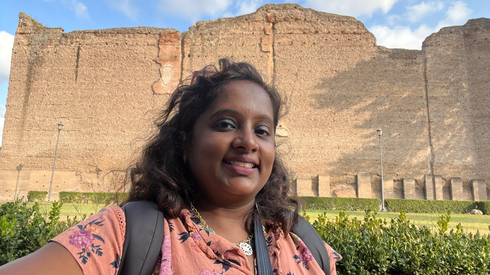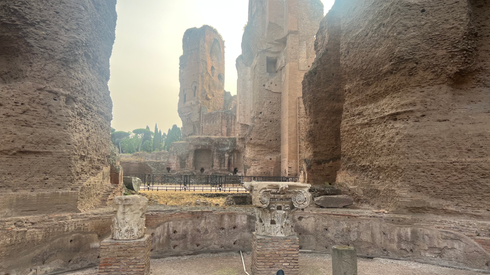Rome - the eternal city, the city of seven hills, an open air museum, and here are my Roman stories from my maiden Italian vacation
- Vaishnavi Pattabiraman
- May 11, 2024
- 17 min read
Updated: Sep 25, 2024

Italy, is popularly known for being one of the most visited countries of the world – with a plethora of Italian travel quotes and blogs (Americaninrome.com, Ourescapeclause.com), numerous YouTube videos and Instagram travelogues, it got into my radar for one of the countries to visit, which in turn resulted in yet another collection of beautiful, memorable, and adventurous travel stories in a few popular Italian regions in late summer of 2023. For starters, Italy consists of 20 administrative regions (insert pic), which are comparable to states or provinces in the U.S or Canada respectively (Italy).

Given this was going to be my first visit to Italy, after poring through the endless content on the internet, I decided to focus my visit on Rome in the Lazio region, Florence & Siena in the Tuscany region and the lovely Cinque Terre in the Liguria region of Italy. Since my preference is almost always quality over quantity, I didn’t pack too many cities to visit into my agenda, instead told myself that I would return to this beautiful country when possible in the future to explore the remaining regions inclusive of but not limited to Venice, Leaning tower of Pisa, untouched parts of Tuscany, and Capri, Sicily, etc.
Fun fact:
Sardinia, an Italian island is home to one of the 5 blue zones of the world (Blue Zones). A blue zone, is a geographical area with longer life expectancy (centenarians are not uncommon in this region), lower rates of chronic diseases, better quality of life in senior years due to a positive lifestyle inclusive of diet, exercise, sense of community, among other factors.
Since my typical writing style is detailed, I will share my Italy travel stories in 2 blogs,
1. Rome in the Lazio region
2. Florence and Siena in the Tuscany region; Cinque Terre in the Liguria region
Rome
The Turkish airlines flew me into the Leonardo Da Vinci Fiumicino Airport (FCO) airport in Rome. After completing the immigration formalities and collecting by baggage, I reached my Airbnb in the Trastevere neighborhood, in the wee hours of August 28th.
Tip: A little planning ahead goes a long way, and as a female solo traveler, it is now ingrained in my DNA to invest a fair amount of time and efforts to plan my travel itinerary in a detailed and straight-forwardly executable fashion so that I feel safe and confident during my adventures in the destination, minimize down time between places of visit, and get on my feet from the time I land in my destination. Given this thought process, I had pre-booked a cab from the airport to my Airbnb in Rome versus waiting for an uber in the wee hours, and this small but critical planning made my commute to the Airbnb a breeze and stress-free. Thanks to my Airbnb host who floated this idea by me during my planning stages.
As we were approaching the Trastevere neighborhood, I noticed narrow-cobbled streets bordered by several restaurants, and cabs, bicycles, and bikes on the streets which instantly reminded me of the narrow-cobbled streets in Italy I have watched on TV. Since I grew up in India and used to the auto-rickshaw drivers maneuvering narrow streets, I wasn’t alarmingly surprised by my cab driver who efficiently maneuvered the narrow streets and neatly parked the cab in front of the apartment building of my Airbnb.
The elevator in the apartment building was super tiny, fitting just me and my luggage, as it was common in Rome and Florence to have such tiny elevators or no elevators in apartment buildings. Some of these things, we take for granted in the U.S. and only during travels to such foreign countries, my faculties are awakened by other realities of the world.
Trastevere, is one of the very vibrant neighborhoods in Rome (Trastevere), located on the other side of the Tiber river, known for its night life, narrow alleyways, numerous restaurants, and piazzas (open squares in Italian towns). It is also walkable to Centro Storico (the historic center) which is home to the ornate Trevi Fountain, Pantheon, the Colosseum, etc. Trastevere is also the second popular neighborhood next to Centro Storico, for staying, during one’s first visit to Rome. And, after checking in and getting situated in my Airbnb, I hit the sack and slept like a baby because of the exhaustion after a rather long journey from home to Rome. Thanks to the comfortable firm mattress in my Airbnb.

Piazza Venezia, Altar of the fatherland, Basilica Santa Maria Maggiore
After a sumptuous breakfast of avocado toast, pista cream filled croissant and a double espresso cappuccino at the Cambio restaurant, next to my Airbnb which would become my go to breakfast place in the upcoming days, I started walking to the Basilica (church/cathedral) Santa Maria Maggiore. During my long walk to the church, I crossed the bridge over the Tiber river, walked by the Piazza Venezia, a public square in Rome where four major roads meet, which has the popular monument called Altar of the fatherland (a popular sunset viewing spot in Rome), walked through Monti, a trendy neighborhood of Rome that has cool restaurants and shops, and home to the Basilica Santa Maria Maggiore that I was heading to. One of the best ways to experience the magic and beauty in Italy is through such long walks.
A Basilica is a class of Roman buildings predating Christianity, is a church, designated by the Pope for its historical, spiritual, and architectural significance (google Basilica to learn more about the same). Rome, has 66 Basilicas (Basilica), more than any other city in the world.
Fun fact: The Basilica Santa Maria Maggiore was one of the first churches built to celebrate the Virgin Mary and hence carries historical as well as spiritual significance.
Fresco is a type of mural painting, painted on freshly laid plaster hence becoming an integral part of the plaster on the walls, ceilings, etc. closely associated with the Italian Renaissance painting (Fresco). My first encounter with one of such Fresco paintings was in the grand cathedral ceilings of the Basilica Santa Maria Maggiore, and this was just the beginning of numerous viewings of the beautiful Frescos in the upcoming days by the best of the best Renaissance period artists – Michelangelo, Raphael, Bellini, to name a few.
The Colosseum and Roman Forum tour (Walks of Italy)
Rome is namesake with The Colosseum, need I say more about this? It was a serendipitous moment, when I happened to watch Gladiator, the blockbuster movie while planning for this trip. I would soon learn from the tour guide of The Colosseum, that the movie Gladiator was not an accurate account of the history shown in that movie because of its historical mistakes, though some of the story was factual. A few key facts about The Colosseum as I learned it in the tour and from my online research.
World’s largest amphitheater, used to be called as the Flavian amphitheater because it was commissioned and completed by the Emperors of the Flavian Dynasty, in Rome.
The infamous Emperor Nero, after the great fire of Rome in 64 A.D., ordered a magnificent palace to be built for himself in the area that had been devastated by the fire which made the Romans unhappy. When he was later deposed and ascended by Emperor Vespasian, the palace was demolished and an amphitheater, was built on that place, between 72 A.D. – 80 A.D. by Emperors Vespasian, Titus, and Domitian. Thus, the Colosseum is ~1,900+ years of age.
This amphitheater was named as The Colosseum, after the colossal bronze statue of Emperor Nero next to the building at that time.
The Colosseum, was a gift to the Romans, where they could seek entertainment during Roman holidays which at that time were 150 days of Roman holidays per year.
Gladiator derived from the word Gladus (sharp sword) that the gladiators carry to the arena for the bloody gladiator battles. If a gladiator survived the bloody fights, they didn’t fight for more than two such battles per year which allowed them to recover from severe wound and infections after the bloody battles.
Gladiator battles continued until the 5th century AD after which the Christian Emperors that invaded Rome stopped these cruel and in human bloodbaths. Animal fights continued between 5th – 7th centuries after which all of these stopped.
An estimated 400,000 human gruesome deaths occurred between gladiators, prisoners, criminals, slaves, and myriad other entertainers, and hundreds of thousands of myriad species of animals inclusive of but not limited to lions, tigers, leopards, wolves, buffaloes, elephants, etc. in the 350+ years this arena was used for the bloodbaths.
Having watched the movie Gladiator prior to my visit to The Colosseum helped me to get into the zone of this historical period during my tour, and I was completely engrossed with the knowledge shared by the tour guide on the tour, and felt overwhelmed with feelings of fear, sadness, anxiety and throbbing pain as I heard the historical gruesome stories that happened at this arena.
Rest of this guided tour encompassed walks through the Roman Forum and Palatine Hill, the ancient Roman structures. The Roman Forum, Palatine Hill and the Colosseum are near each other at the center of the city of Rome. Legend states that it was here, thousands of years ago, Rome was found by Romulus. The sublime collection of historical Roman buildings bordering the Forum includes temples, government buildings, triumphal arches, and basilicas – such as the Senate building, the largest Roman temple dedicated to Venus and Rome, the Arch of Titus and the Arch of Constantine, and the House of the Vestal Virgins.
Fun fact: Rome is popularly known as the Open-Air Museum – because of the numerous basilicas, arches, Colosseum, and ruins peppered through the city. Roman Forum, Palatine Hill provide wonderful snapshots of ancient Rome, with so much to offer for archaeologists and historians.
There is so much history in the Roman Forum and Palatine Hill and one can look these up online for further historical education. Two things that caught my attention and interest as a person with little to knowledge about Roman history were – the House of Vestal Virgins and the Julius Caesar temple created in his memory in the Roman Forum.
Vestal Virgins were 6 priestesses, selected to tend to the temple of Vesta in the Roman Forum. The temple of Vesta was one of ancient Rome’s most important buildings dedicated to the Roman Goddess of the hearth, the temple conserved the city’s sacred flame, symbolic life-force of the entire Roman state. Vestal virgins were 6 in number at any time, much highly regarded and the most powerful women of Rome, who were the daughters from the notable families of Rome. They were shouldering huge responsibilities that were often onerous, and a slight slip-up in their duties or a slight disregard to their chastity could result in severe punishments such as being burned alive (Vestal Virgins). They had several privileges during their 6-year term at the temple and after their service ended as well. The statues of many of these Vestal Virgins were headless, and I don’t exactly recall the reasons explained for this by the guide.
The Julius Caesar temple in the Roman Forum was the spot where the remains of Julius Caesar after his assassination was buried and a temple was built on top of it to honor him.
Tour of the Vatican Museums, Sistine Chapel, and St. Peters’ Basilica (Walks of Italy)
Vatican city, is a landlocked independent country within Rome, which became independent from Italy in 1929. It is the smallest country of the world (Vatican city). It is home to the Pope, and Vatican Museums are a trove of iconic art and architecture. Michelangelo’s ceiling frescoes in the Sistine Chapel, the Renaissance frescoes in the Raphael rooms, numerous marble sculptures, hand woven tapestries in the Vatican Museum and so much more historical details were shared during this guided day trip.
Because of a busy previous day in The Colosseum and the Roman Forum, that included walking 20,000+ steps on day 1 of my Italian vacation while I was still getting over the jetlag, I was sleep deprived, and exhausted during my visit to the Vatican City hence didn’t absorb a lot of historical details shared by the guide during this guided trip. Nevertheless, the stupendous ceiling paintings in the Sistine Chapel by Michelangelo, ‘The Last Judgment’ and ‘The Creation of Adam’, plus Raphael’s frescos in the Vatican Museum were definitely worth the visit. As shared by the tour guide, I was enlightened about the following interesting stories of the two most popular renaissance artists – Michelangelo and Raphael.
Michelangelo was a lone wolf, wealthy but stingy and never removed his boots. When he died at the age of 84, they struggled to remove his boots from his foot because of how tightly connected it was to the skin.
Raphael worked with his team, delegated his work among his students and died at an early age of 37 due to syphilis. Some of their works from the Vatican museums are shared below. Other works of art that captivated my interest were hand woven tapestries and the various marble sculptures which were excavated from earth and put in display in the Vatican museums.
One of the most captivating and popular marble sculptures in the museums is the statue of Laocoon and His Sons (Laocoon and His Sons) which was excavated in Rome in 1506. The legend says that the Trojan priest and his two sons were attacked and killed by sea serpents. As a non-historian, I was engulfed during my visit by the most painful expressions on the father’s face, and expressions of fear, and sadness on the elder son’s face watching his father helpless as they were being killed by the serpents. And I crossed paths with a replica of the same statue in the Uffizi gallery in Florence which could be why I am attracted to this statue and remember it quite well when compared to so many other art pieces I saw in the Vatican museums.
St. Peter’s Basilica visit was just alright, the tour guide by this point was towards the end of the tour, hence rushed through the description of the basilica and I didn’t learn much from my visit. Apparently, there is so much history and significance of this basilica which visitors to this blog can learn online. For certain, the beautiful frescos on the ceiling were truly extraordinary and it was the tallest cathedral among the ones I have seen so far. I learned that the height of the cathedral from bottom to the top of the dome is 400 meters.
Castel Sant’ Angelo
The Mausoleum of Hadrian (the Roman Emperor), also known as Castel Sant’ Angelo is a towering cylindrical building in Rome, walkable (~ a 30 minute walk) from St. Peters’ Basilica. Again, there is quite a bit of history behind this monument like anything else in Rome, briefly, Hadrian and his family’s ashes were placed in the cylindrical building Castel Sant Angelo.
Best part of my visit to this monument were the 360° sweeping views of the city of Rome from the terrace of the Castle. The climb to the terrace was of moderate difficulty and doable. The all-encompassing, obstruction less views of St. Peters’ Basilica, Sistine Chapel, Tiber river and the city of Rome were a remarkable memory.
Piazzas, are public squares or market places commonly seen in Italy. In Rome, one can bump into a Piazza quite frequently. Piazza Navona (Piazza Navona ) is one of the most beautiful piazzas in Rome. An elongated square of immense historical significance, this square is home to the church Sant ’Agnese in Agone, commissioned by pope Innocent X who then commissioned the renaissance artist Bernini to build ‘The Fountain of the Four rivers’, one of the most photographed fountains in this square. This square also has two smaller fountains by Giacomo della Porta, an apprentice of Michelangelo – ‘The Fountain of the Moor’ and ‘The Fountain of Neptune’. It was a beautiful, sunny afternoon during my visit to this Piazza where I had my delicious pesto pasta lunch while sinking in the pretty sights of the square followed by a stroll in the square post lunch.
Fun experience: Such intangible experiences are the perks of solo travels, where soaking in the experiences of the surroundings, can be undeterred and more feasible than while traveling with a group.
Walking tours led by the local guides is one of my favorite things to do while visiting a city for the first time. And for a city deeply rich in history like Rome, this was a no brainer, and my research helped me to identify one such walking tour - (Rome by night ), Sandeman’s offers free walking tours led by the local guides in a few European cities though a tip at the end of the tour is generally much appreciated. A few highlights from the night walking tour were,
The iconic Trevi fountain (Trevi Fountain), one of the most stunning fountains in the world is a must visit after dusk or in the dark while in Rome for a different experience when compared to an experience during a day time visit. I don’t think the crowd ceases at any time of the 24-hour day around the Trevi fountain. Why is this Trevi fountain such an iconic place of visit in Rome?
Built in the 1700s, the Trevi fountain It is at the junction of three roads, hence the name tre vie, the Three Roads Fountain.
It was constructed from the same material, the travertine stone which was used to construct the Colosseum.
The popular myth is the if a visitor throws one coin into the fountain is guaranteed a visit to the eternal city (Rome), if they throw a second coin, they are bound to find love and a third coin calls for wedding bells.
On average €3000 are collected every night from the fountain, which is used for charitable purposes.
Fun fact: Rome is equipped with more than 2,500 drinking fountains, known as nasoni, which provide residents and visitors with free fresh and clean water all year around. History says that ~5,000 or so fountains were first introduced in the early 1870s to provide free water for its citizens, and the water from these fountains are safe and potable as it is the same water that flows into Roman homes. This is such a boon to the millions of visitors during summer months, because visitors can be assured of refreshing and clean water to refill their water bottles as needed during their sight-seeing under the scorching sun.

Majestic views of the Roman Forum, the Pantheon and other sights in the dark
I highly recommend going on one of these walking tours of the city with a local, which would be an enriching travel experience.
The Pantheon, the Trevi fountain, the Spanish steps and the Baths of Caracalla
My final sight-seeing day in Rome was spent on exploring the Pantheon, the Trevi fountain during the day, the Spanish steps and the Baths of Caracalla (Roman ruins). The Pantheon, is one of the most preserved monuments of ancient Rome, as well as one of the most visited Roman monuments. It was constructed as a temple dedicated to various Roman Gods and became the burial ground for many important artists and kings. Among the popular Roman historical people, It houses the tomb of Raphael, an incredible artist of the Renaissance.
Fun fact: History aside, what I found very interesting during my visit to the Pantheon was that the dome had an opening in it which meant that the rainwater enters the monument. There were 22 holes on the concave floor which allowed the rain water to seamlessly flow through without flooding the monument, a smart architectural design that captivated my non-Engineering brain.
The Trevi Fountain during the day was thronged with people as anticipated. It felt nice to have visited this fountain during the day as well as after dark.
Safety tip: I read online that because of how busy and crowded it is around the Trevi fountain, there are immense opportunities to get pick pocketed or lose valuables in this area if the visitors are inattentive. So, please be extra cautious about your belongings including your children while you are enjoying the views of this majestic fountain.
The Spanish Steps (The Spanish Steps) is one of the most important landmarks in Rome. These are the widest 135 steps in Europe, from the Piazza di Spagna, one of the beautiful public squares in Rome at the bottom of the steps to Trinita dei Monti, a French church, at the top of the steps. A few historical tidbits about The Spanish Steps,
It is a symbolic connection between the French and Spanish, built in the 18th century, replacing a wooded hill that separated the French church and the public square named after the Spanish embassy, as explained above.
John Keats, a popular English poet died in the house overlooking these steps.
The Spanish Steps have made their way into many popular Hollywood movies such as Roman Holiday, Talented Mr. Ripley and in the popular sitcom Everybody loves Raymond among many others.
I climbed up the 135 steps and enjoyed the views along the way from the 3 terrace levels. It is an easy climb up the stairs, so definitely worth visiting while in Rome.
Baths of Caracalla, a Roman ruin was my final sight-seeing stop in Rome. The Thermae Antoninianae (Baths of Caracalla) was one of the largest and best preserved thermal complexes of antiquity, entirely built by the Emperor Caracalla since AD 212 (Baths of Caracalla).
The baths were supplied by Aqua Nova Antoniniana, a new branch of the Aqua Marcia aqueduct.
The rectangular plan of the building is typical of the great imperial baths.
There were pieces of beautiful mosaic floors, a few of these floors were studded with stones in the ruins, which explained that such grandiose floors existed in this thermal complex before it became a ruin.
The decorations and works of art were spotted in the thermal complex through displays of model pieces. Seemingly the baths were adorned with columns, previous marble slabs on the pavements and on the walls, stucco paintings hundreds of statues and colossal sculptures.
The Romans liked board games, and they played these games while seated in the water at the edge of large pools.
Tip: When I visited the baths, it was a couple of hours before the closing time, and the number of visitors were sparse in comparison to the thronging crowds in other areas of Rome. You may want to do your research before you head out to the Baths of Caracalla, but based on what I experienced I think this could easily be one of those hidden gems in Rome, with relatively lesser crowds.
Some restaurant suggestions below which I visited and liked,
Cambio in Trastevere, was steps away from my Airbnb and they carried good breakfast/brunch options. Their cappuccino with double shots of espresso, pistachio cream croissants and the avocado toast were some of my favorites Cambio.
Tonnarello in Trastevere, was a popular suggestion in the Facebook Italy groups, and hence I checked out this restaurant for dinner. I wasn’t too surprised when I joined the long line to the restaurant given the popularity of this restaurant. And their pesto pasta was delicious, their Tiramisu was one of the best I had in Italy Tonnarello.
Fun fact: It was by chance that I opted forTiramisu in Tonnarello, little did I know that this event would lead me to consume more of this dessert during my vacation in Italy. Because of how good it was on my first attempt in Tonnarello, I chased the same dessert during the rest of my Italy trip. Maybe I didn’t know how to choose a good gelato place in Rome, because the gelato I had consumed in a place in Trastevere wasn’t any better than what we get in the US, hence I wasn’t thrilled about gelatos on this trip contrary to the popular belief that best gelatos are synonymous with Italy.
This brings to the end of my Rome stories. Stay tuned for more heartfelt travel stories of the Tuscany and Liguaria regions in my next blog.
Helpful tips and observations
How many days would suffice in Rome for a first-time traveler? Answer is subjective, though I did 3 full days in Rome for the things covered in this blog. If one is on a time crunch, they could fit most of the things covered in this blog in 2 days, but 3-4 days would be ideal to take in the history at an enjoyable pace without feeling rushed.
Safety first: Rome, Florence, Venice, Milan are some of the most popular and heavily crowded tourist ciites in Italy, especially in the summer months subjected to numerous pick-pocketing opportunities to the extent where the tourists have even lost their passports. Hence, after reading through the recommendations by tourists in travel blogs, I invested in a Travelon hand bag, which has a few anti-theft points such as locked zippers, slash resistant straps, RFID pockets, etc. If anything, securing my valuables - passport, credit cards, cash in this bag during my travel in Italy gave me a sense of immense peace and security. So, I recommend a bag with such safety features for the reasons described.
I am a proponent of well-rated guided tours to get the most of my time for the things that interest me during my travels. As described above, I went on a couple of guided tours with Walks of Italy https://www.walksofitaly.com/rome-tours/ , and felt that the Premium Colosseum Tour with Roman Forum and the Palatine Hill was really worth my time and money.
As mentioned in my previous travel blogs, I highly recommend joining one or two travel groups on social media like Facebook groups for example. This is a great resource especially during the planning stages of the travel.
Couple of high-quality travel blogs on the internet that were immensely helpful with my planning:
Earth trekkers at https://www.earthtrekkers.com/
Wheatlesswanderlust at https://wheatlesswanderlust.com/
Carry euros if possible, because it comes in handy for transactions where credit cards are not accepted.
The cobblestone streets are very beautiful and alluring for sure, but they work your feet really hard that you would be left with aches at the end of the day after long walks, to mitigate such pains wear good walking shoes, that offer great support to your feet.
Restaurants in Italy have seatings on the streets, and it is a common sight to see people dining late into the night with their friends and families, and the restaurants remaining open through past midnight. I enjoyed seeing such sights with so much life after dusk, so if you are like me, take advantage of late evening strolls on the streets to feel the energy of the crowd.


































































































































































































